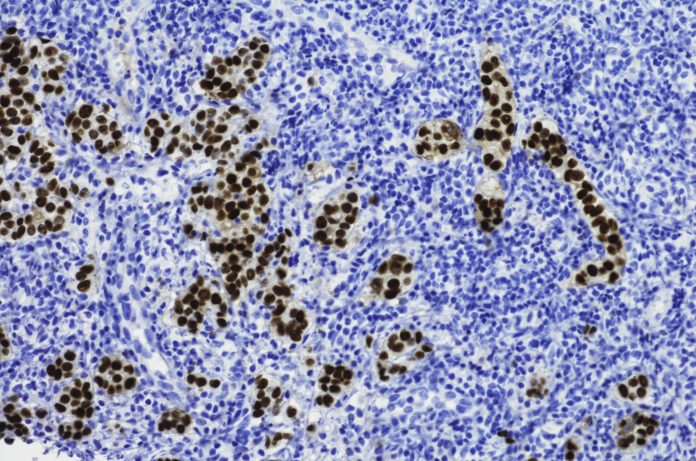
New findings by researchers at Duke University School of Medicine indicate that chronically high levels of cholesterol are associated with increased risk of breast cancer, and with worse outcomes in most cancers. To date, the link between high cholesterol and cancer hasn’t been fully understood, but the mouse studies by a Duke Cancer Institute-led team have now identified a mechanism that underpins how breast cancer cells use cholesterol to develop tolerance to stress, making them invulnerable as they migrate from the original tumor site.
The research showed that chronic exposure to the cholesterol metabolite, 27HC, effectively selects for cells that exhibit increased cellular uptake and/or biosynthesis of lipids, and these cells show much greater metastatic capacity. The results also showed that the metabolic stress imposed upon cells by the accumulated lipids requires sustained expression of GPX4, a negative regulator of ferroptotic cell death.
“Most cancer cells die as they try to metastasize—it’s a very stressful process,” said Donald P. McDonnell, Ph.D., professor in the departments of pharmacology and cancer biology and medicine at Duke University School of Medicine. “The few that don’t die have this ability to overcome the cell’s stress-induced death mechanism. We found that cholesterol was integral in fueling this ability … Unraveling this pathway has highlighted new approaches that may be useful for the treatment of advanced disease. There are contemporary therapies under development that inhibit the pathway we’ve described.”
McDonnell is senior and corresponding author of the researchers’ published paper in Nature Communications, which is titled, “Dysregulated cholesterol homeostasis results in resistance to ferroptosis increasing tumorigenicity and metastasis in cancer.”
Hypercholesterolemia and dyslipidemia are associated with an increased risk for many cancer types, and with poor outcomes in patients with existing disease, the authors explained. “Obesity, dysregulated lipid homeostasis, and other sequelae of the metabolic syndrome are associated with increased risk of breast cancer and with poorer outcomes in patients with established disease.”
In particular, they noted, there has been significant interest in identifying the impact of cholesterol on breast cancer pathogenesis, because hypercholesterolemia is a risk factor that could be modified by diet, and/or through the use of drugs. There is considerable evidence that hypercholesterolemia is an independent risk factor for breast cancer in postmenopausal women, the investigators stated. But while studies that have evaluated the use of statins (the most commonly used LDL-cholesterol-lowering drug) on breast cancer risk in postmenopausal women have yielded equivocal results, “more compelling,” the authors noted, are the results of some large studies that have demonstrated significant benefits, in terms of overall and disease-free survival, for patients taking a statin before or following a cancer diagnosis. “Understanding the different effects of hypercholesterolemia on disease incidence versus established disease will inform the development of new approaches to modify this axis for maximal therapeutic benefit,” the researcher stated.
The newly reported research by McDonnell and colleagues builds on earlier work in their lab focusing on the link between high cholesterol and estrogen-positive breast and gynecological cancers. Those studies found that cancers fueled by the estrogen hormone benefited from derivatives of cholesterol that act like estrogen, stoking cancer growth.
“Notably, we and others have determined that 27-hydroxycholesterol (27HC), an abundant oxysterol and a primary metabolite of cholesterol, functions as a bona fide endogenous SERM (selective estrogen receptor modulator), supporting the growth of ER-positive tumors in several models of luminal breast cancer,” they continued. “It appears likely, therefore, that some of the benefits of statins on the survival of postmenopausal breast cancer patients with ER-positive disease is attributable to their ability to reduce 27HC production.”
But a paradox emerged for estrogen-negative breast cancers. These cancers are not dependent on estrogens, but high cholesterol is still associated with worse disease, suggesting a different mechanism might be at work. “However, given that 27HC is generally thought to be a negative regulator of cholesterol synthesis and uptake … and considering the requirement of proliferating cells for cholesterol, it was unclear how hypercholesterolemia could have a net overall positive effect on cancer cell growth and metastasis.”
Through their latest study using cancer cell lines and mouse models, the Duke researchers have now found that migrating cancer cells take in cholesterol in response to stress. And while most die, in a what-doesn’t-kill-you-makes-you-stronger motif, the cells that do survive emerge with the ability to withstand ferroptosis, a natural process in which cells succumb to stress. These stress-impervious cancer cells then proliferate and readily metastasize. The process appears to be used not only by ER-negative breast cancer cells, but other types of tumors, including melanoma. And the mechanisms identified could be targeted by therapies.
“In this study, we demonstrate that chronic exposure of cancer cells to 27HC, that which likely models the situation in patients with hypercholesterolemia/dyslipidemia, results in the emergence of cells exhibiting increased tumorigenic and metastatic capacity,” the team noted. “The metabolic stress associated with increased lipid accumulation requires the expression of the lipid peroxidase GPX4, a key negative regulator of ferroptotic cell death.”
Importantly, the studies showed that resistance to ferroptosis is a feature of metastatic cells, and demonstrated that knocking down GPX4 weakened the otherwise enhanced tumorigenic and metastatic activity of cells chronically exposed to 27HC.
Interestingly, the team researchers pointed out, GPX4 and the GPX4 pathway have received considerable recent attention as therapeutic targets, and there are several GPX4 inhibitors in development, “… although it remains to be determined if their therapeutic index will be good enough to permit their use in cancer patients.” Even so, as McDonnell concluded, “Importantly, these findings yet again highlight why lowering cholesterol—either using drugs or by dietary modification—is a good idea for better health.”













